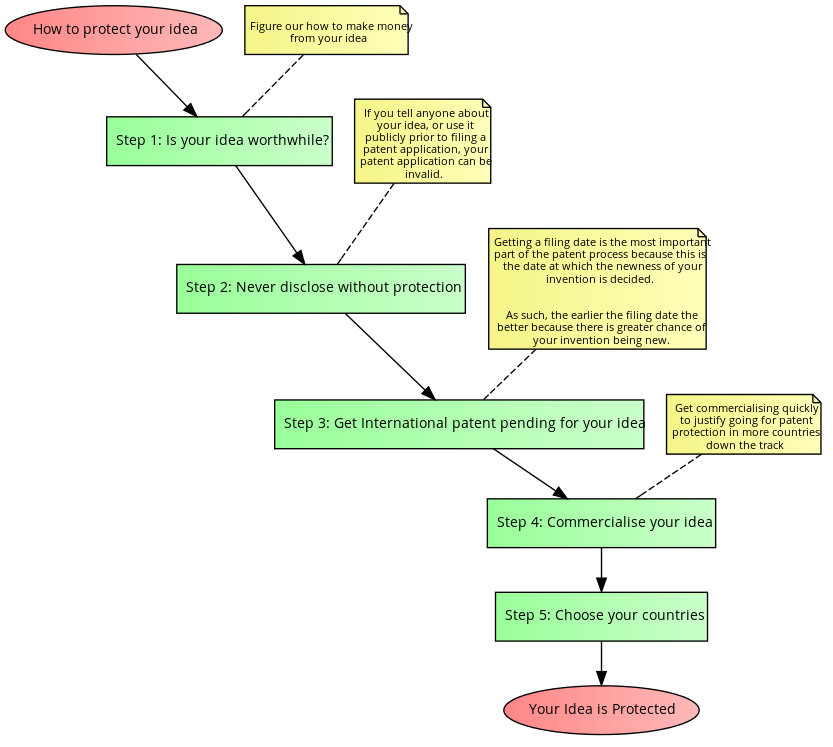If you have a commercially viable idea, you should know how to protect your idea against theft. Patentec Patent Attorneys will help patent an idea and guide you through the process of protecting your idea both in Australia and overseas.
The following steps will guide you through the process of obtaining international patent pending with a view to initially bringing your idea to the market to test its commercial viability before deciding on those countries for eventual patent protection.
Firstly, let’s have a look at the patent application process:

Flowchart for protecting your idea in Australia and overseas
Step 1: Is your idea worthwhile?
Before you even consider patent protection, you must first consider whether your idea is commercially viable. You don’t want to go to the effort of obtaining patent protection for an idea that wont sell.
First consider whether your idea is commercially viable
As such, your first step is to do a back-of-the-envelope business plan to find ways in which you can make money from your idea. There are a number of ways in which to commercialise your idea. Firstly, you could look to produce and bring the idea to the market yourself, such as by having your product manufactured, or your software coded and launched on the App Store, looking to use your patent protection to keep your competitors at bay.
Alternatively, you could look to licence your intellectual property to others such that others would pay you royalties for the rights to use your invention. While royalty rates differ across technologies, and while you will generally try and get a licensee to pay the highest royalty possible, by way of guidance, for mechanical type inventions, one could usually expect to attract a royalty of about 6% of sales price.
Licensing of intellectual property is usually a cost-effective strategy to avoid the initial development costs. For example, having a software application developed could cost anywhere between $30,000 and $100,000 in Australia. By leveraging off your patent application, you can get someone else to incur these costs while still attracting royalties.
Step 2: Never disclose your idea without protection.
If you tell anyone about your idea, or use it publicly prior to filing a patent application, your patent application can be invalid. While there may be certain ways to get around this by using grace period provisions for those countries that have them (please feel free to contact us about more information about grace periods) the general rule is never disclose without protection.
Never disclose without protection
As such, once you have satisfied yourself that you can make money from your idea, we recommend getting a filing date for your idea right away.
Step3: Start off with International patent pending
Getting a filing date is the most important part of the patent process because this is the date at which the newness of your invention is decided (i.e. the earlier the filing date the greater chance of your invention being new) and the date whereafter others could infringe your patent (i.e. others can only infringe your patent if they started exploiting the granted claimed invention after the filing date of your patent application).
Establish an international filing date
Patentec specialises in establishing strong international filing dates with our thoroughly drafted patent applications increasing the chances of your patent application surviving examination and allowing for greater opportunity for capturing patent inringement.
The first stage of the international patent pending stage gives you 12 months of commercialisation “breathing space” during which you can bring your idea to the marketplace, approach investors, joint-venture partners and the like without jeopardising your patent rights in your idea.
Step 4: Commercialise quickly
As soon as you have established an international filing date it is vitally important that you get going straight away with commercialisation. The reason is that at the end of the initial 12 month international patent pending stage you must decide how to continue with the patent process. This decision essentially depends on feedback from the initial commercialisation process.
Commercialise rapidly to as to be able to make an informed decision at the end of the initial 12 month international patent pending period as how best to continue with the patent application process
Step 5: Choose your countries
At the end of the international patent pending period, you may select certain countries for eventual patent protection, such as Australia, the United States, China, Europe and many more.
You can also extend the international patent pending period by a further 18 months using the PCT patent application.
In each of these countries, your patent application will be examined and you will obtain granted patent for those aspects of your invention that are new.
At this time, your idea should be commercialising well and you will be leveraging off your patent protection in each country to give you 20 years of exclusivity during which no one else can export your idea.
In summary, if you have a great idea that you believe is commercially viable it is vitally important that you get in touch with Patentec patent attorneys for guidance on the process of protecting your idea both in Australia and overseas.
